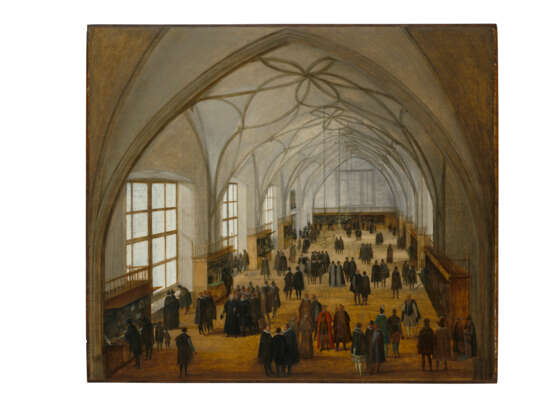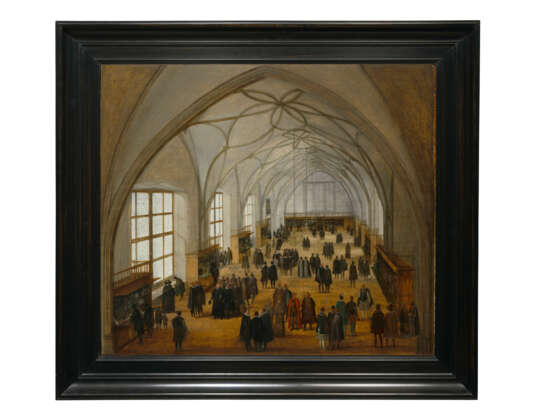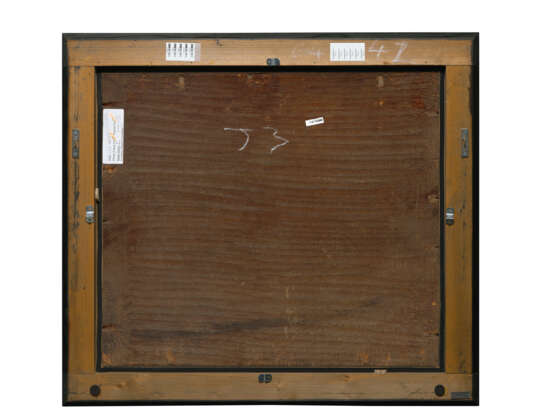ID 1336088
Lot 22 | HENDRICK VAN STEENWYCK LE JEUNE (ANVERS 1580-1649 LEYDE)
Estimate value
€ 60 000 – 80 000
La Salle Vladislav de l'Ancien Palais royal du château de Prague
signé 'H STEENW...' (en bas, à droite, sur la première boutique)
huile sur panneau
53,4 x 61,4 cm (21 x 24 1/8 in.), bordé de baguettes de bois de 0,3 cm ( 1/8 in.) le long des bords inférieur et supérieur
Provenance
Chez Walter Carl, Francfort-sur-le-Main, en 1919 (comme Hendrick van Steenwyck l'Ancien - selon F. Hoeber, 1919, op. cit. infra).
Vente anonyme, Hugo Helbing, Francfort-sur-le-Main, 21 mai 1935, lot 60 (comme Hendrik van Steenwyck le Jeune, consigné par 'S' [peut-être 'Simon']).
Vente anonyme, Christie's, Amsterdam, 16 novembre 2006, lot 111 (comme Hendrik van Steenwyck l'Ancien ou Hendrik van Steenwyck le Jeune) ;
Acquis au cours de celle-ci par le père des actuels propriétaires.
Literature
F. Hoeber, 'Deutsche Kunstmesse', Der Cicerone: Halbmonatsschrift für die Interessen des Kunstforschers & Sammlers, 1919, XI, 23, reproduit en noir et blanc p. 776, fig. 11 (comme Hendrik van Steenwyck l'Ancien - 'Buch und Kunsthandel auf der Börse von Amsterdam').
G. T. Faggin, La pittura ad Anversa nel Cinquecento, Florence, 1968, p. 83, sous la note 62 (comme Hendrick van Steenwyck l'Ancien).
J. Howarth, The Steenwyck Family as Masters of Perspective, Turnhout, 2009, pp. 122-123, n°I.62 (comme Hendrick van Steenwyck l'Ancien), reproduit en noir et blanc p. 407.
M. Wolters, 'Een nieuw perspectief. De ondertekening in De Wladislawzaal door Hendrik van Steenwijck II', RKD Bulletin : Bijdragen voor Rudi Ekkart. Bij zijn afscheid als directeur van het RKD, 2012, 2, pp. 207-212, reproduit en noir et blanc p. 209, fig. 2 et sous réflectographie infrarouge p. 210, fig. 3 et p. 211, fig. 4.
Further Details
HENDRICK VAN STEENWYCK THE YOUNGER (1580-1649), THE VLADISLAV HALL AT THE CASTLE IN PRAGUE, OIL ON PANEL, SIGNED
The Vladislav Hall, with its impressive gothic vaulting, was originally built in 1487 as a banquet hall and throne room for King Vladislav Jagiellon (1456-1516), King of Bohemia and later also of Hungary and Croatia. By the time of Rudolf II (1552-1612), Holy Roman Emperor, the expansive room also came to serve as a marketplace for art and fine objects, thus here depicting what can be considered as the world’s first art fair.
Having never been to Prague himself, Steenwyck the Younger (1580-1649) based this intricately detailed depiction of Vladislav Hall on an engraving dated to 1607 by Aegidius Sadeler II (before 1568-1629), court engraver to Rudolf II. Regularly referencing engravings as a basis for his compositions, the artist here adapted Sadeler’s print to his own purpose (see A. Koopstra, T. Fusenig, 'New Insights into Hendrik van Steenwijck the Younger's Working Methods and Milieu', Journal of Historians of Netherlandish Art, 11:1, Winter 2019, Appendix, pp. 1-28). Infrared reflectography has revealed extensive underdrawing in the rendering of the Hall, showing Steenwyck’s reinterpretation of the scene in his own unique idiom. Most notably, the artist has chosen to remove the ornate Renaissance door at the far end of the hall and the stalls in the window niches. This, and the slightly pared back staffage, creates an elegantly simplified view that allows the ornate vaulting to play a more important role in the overall composition, while also allowing the light to penetrate the space and illuminate the vignettes of human interaction.
Other artists also took Sadeler's work as inspiration, including one now attributed to Bartholomeus van Bassen (1590-1652) in the Martin von Wagner Museum, Würzburg (inv. no. F 276). Rather than adapt the print, however, Bassan followed it more slavishly.
Dendrochronological examination of the present panel carried out by Dr. Peter Klein in 2009 (available upon request) has shown that the youngest heartwood ring dates to 1609, allowing for an earliest creation date of circa 1628, confirming its place within Steenwyck the Younger’s early maturity.
| Artist: | Hendrick van Steenwijk II (1580 - 1649) |
|---|---|
| Applied technique: | Oil on panel |
| Art style: | Old Masters |
| Genre: | Genre art |
| Place of origin: | Belgium, Western Europe, Europe |
| Auction house category: | Paintings, Watercolors, Drawings, Paintings |
| Artist: | Hendrick van Steenwijk II (1580 - 1649) |
|---|---|
| Applied technique: | Oil on panel |
| Art style: | Old Masters |
| Genre: | Genre art |
| Place of origin: | Belgium, Western Europe, Europe |
| Auction house category: | Paintings, Watercolors, Drawings, Paintings |
| Address of auction |
CHRISTIE'S 8 King Street, St. James's SW1Y 6QT London United Kingdom | |
|---|---|---|
| Preview |
| |
| Phone | +44 (0)20 7839 9060 | |
| Buyer Premium | see on Website | |
| Conditions of purchase | Conditions of purchase |





